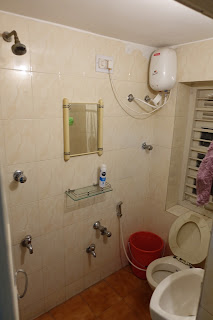I spent the day on Sunday with Anil, a lathe turner as I
watched him 15 pieces on his traditional lathe.
Anil has been turning all his life, his father was also a
turner and his 13-year-old son also plans to be a turner.
 |
| Anil turning a chair leg |
The lathe; Western style lathe turning is done standing up,
in India, it is done sitting down. Often the feet are also used in the process,
whether to help press sandpaper or lacquer stick against the piece, holding the
piece in tension between the lathe centers, or even guiding the tools when
shaping the wood. When turning a spindle on a western style lathe, one end has
teeth in it that grabs the piece and spins the piece driven by an electric motor.
On an Indian style lathe, a notch is turned and a rope belt is put into that
notch and it runs off a motor mounted in the rafters above your head. These are
the primary differences. The tools are more limited but similar.
 |
| Tools, only gouges & scrapers all made by a blacksmith |
 |
| Making pieces |
A pretty cool video does a nice job explaining some of this:
https://www.youtube.com/watch?v=tsTC_4B7V70
Traditional powerless lathe turning is a real thing to see
here but is becoming much less common.
 |
| Traditional turner in Kutch |
I have decided to really focus on a specific craft tradition
– lathe turning, though some other craft forms will show up in the finished
work. I am using reclaimed materials, principally Burmese Teak and (for those
who are curious) I am paying $2 to $3 a board foot for it. I actually buy by
the kilogram and I am paying 70 to 100 rupees per kilo. It is a beautiful hard
wood that is brutal on tools but very dry and very stable and I am really happy
about reusing old wood.
These pieces will be are a combination of
digital fabrication and traditional craft. For
example, I have designed a chair that will have a seat digitally fabricated on
a CNC router with legs turned by Anil. I will post images as soon they exist. I
am also working with a “ digital guy” Rudrapalsinh – RP to those of us who really suck at
Indian pronunciations. He is modeling my pieces in Rhino and doing the files
for the CNC machines.
 |
| Design - piece |
Back to turning; In about 6 hours Anil turned 15 pieces, 4
chair legs, 2 tall pedestal legs (the bases will be carved stone) legs for a 3
legged pedestal, 4 table legs and some pieces for the back support on a second
chair design.
The really special thing (I think) about Gujaratti turning
is the use of lac sticks. In a nutshell sticks of color (imagine very hard
crayons) are made by Anil and his apprentices and through the heat created by pressing
the sticks against the spindles while it is turning, the coloured lacquer is
deposited on the piece. A very cool process that I shot a lot of video of and
the next day discovered that my camera for some unknown reason saved none of
it.
 |
| Lacquer work |
 |
| Finished pieces |
This is just the first round. The plan is to have another
set of turnings made for numerous pieces that will become part of my final
exhibition. Then have more made to bring home with me so that I might produce
some prototypes in the states.
 |
| Neighbors |










